Colchicum magnificent: description and cultivation
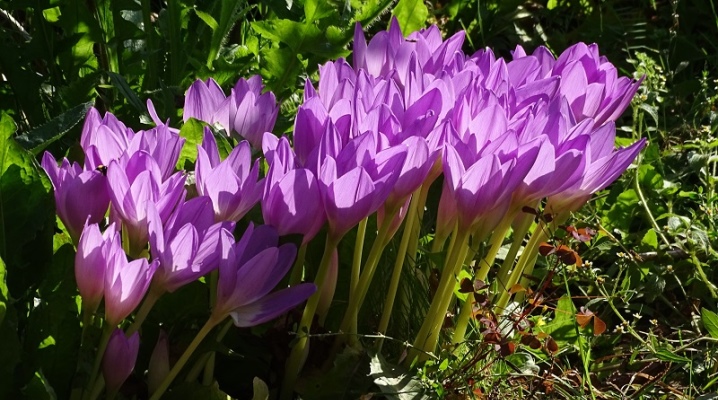
Backyard owners rarely limit themselves to planting exclusively edible crops. They also want to decorate the space, for which a variety of flowers are purchased and planted. Some choose the classics: asters, lilies, gladioli, dahlias, peonies. Others want something unusual and choose flowering wild plants for planting in the garden. One such plant, the magnificent columbus, will be discussed in our article.


Description
Colchicum (Colchicum speciosum) is a herb belonging to the Colchicum family. It grows in the warm climate of Georgia, the Caucasus, the Krasnodar Territory, as well as Iran and Asia Minor.
Botanical Description:
- height - up to 40 cm;
- rhizome - a bulb that has an elongated shape, its length is 5 cm, width is 3 cm;
- the length of the leaves of an adult colchicum is 3.5 cm above, 7 cm below, 6 leaves in total;
- the magnificent autumn crocus begins to bloom in late August-September and continues until the end of October;
- during the flowering period, 4 flowers may appear on the bush, which can be both pink and purple;
- when the ground part of the colchicum dies off, fruits ripen in the ovaries, which, with the arrival of spring, grow in parallel with the young foliage, they finish ripening in July;
- is a poisonous plant.

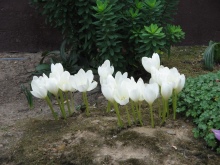
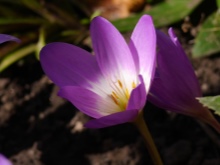
Varieties
Before you begin to describe the popular varieties of the magnificent autumn crocus, let's get acquainted with its forms.
- Colchicum speciosum f. album - white uniform. The flowers are large, snow-white.
- Colchicum speciosum f. atrorubens - dark red shape.
- Colchicum speciosum f. ordu. The flowers of this form are smaller than those of the others, the petals are narrower, the color in the center is snow-white.
- Colchicum speciosum f. dombai or Dombai form. Almost identical to the previous one, however, the flowering period occurs later.
- Colchicum speciosum f. giganteum or a giant colchicum. It was named so because of the size of the bulb. The color of the petals is light lilac, the core is white, the perianth is cupped.
- Colchicum speciosum f. turkey - Turkish form. It has goblet flowers of a bright lilac shade, white in the middle.
- Colchicum speciosum f. rubrum - differs from others in large red flowers.
- Colchicum speciosum f. veratrifolium or hellebore form. It has folded leaves and large lilac flowers.


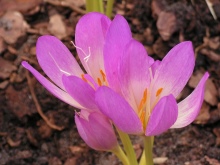
Well, now it's time to get acquainted with the varieties of the magnificent colchicum. Most of them are obtained by hybridizing this species with others. To begin with, consider those that bloom in the first half of September.
- Autumn Queen. The height of the flower is up to 25 cm. The petals have a dark purple hue, are decorated with a "checkerboard" pattern, the core is white.
- Beaconsfield. The stem does not exceed 25 cm in height, the flowers are bright, purple, with burgundy anthers and a variegated pattern. Abundant flowering.
- Violet Queen. It grows up to 20 cm in height, has bright lilac flowers with a "checkerboard" pattern and orange stamens.
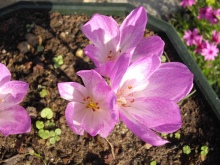
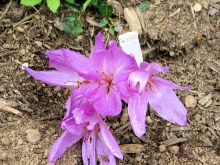
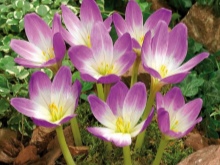
Varieties blooming all September.
- Antares. Plant height - 20 cm. The flowers are large, the petals are light purple on the outside, and on the inside - white with light purple tips.
- Attlee. It also does not exceed 20 cm in height. It has purple flowers with a white core.
- E. A. Bowles. A rare variety. Stem - 20 cm in the form of a purple tube, petals are pale lilac, greenish-white in the middle.
- Gracia. Grows up to 20 cm in height. The petals of the flower open wide, have lilac petals, whitening towards the center.
- Jarka. The stem is 20 cm. The flowers are pinkish-lilac, the petals taper towards the tips and acquire a white color.
- Lilac Bedder. Plant height - 20 cm. Flowers are pale purple, white center.
- Poseidon. Low-growing variety - only 15 cm in height. The stem is thickened. The petals are mauve-colored, the color is uniform, the anthers are reddish.
- Zephyr. It grows up to 25 cm. The flowers are purple, the middle is white-green.
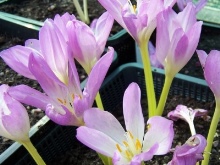
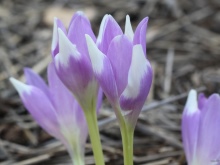
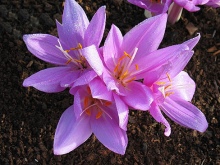
Now the turn of the varieties has come, pleasing the eye in the second half of September.
- Glory of Heemstede. The stem does not exceed 20 cm in height. The flowers are rather large, lilac-pink, variegated, the core is white.
- Harlequin. Newly bred variety. The green tubular stem grows up to 20 cm in height. The petals are lilac, the middle is snow-white. Tepals are turned inward.
- Lilac Wonder. Plant height - up to 20 cm. Flowers are mauve, variegated, petals are elongated, narrow. The flowering period is quite long. One bulb can "release" up to 20 flowers.
- Waterlily. Terry variety, very beloved by gardeners. Stem height - 20 cm. The flowers are lush, with narrow pink petals up to 15 cm in diameter.
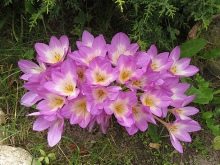
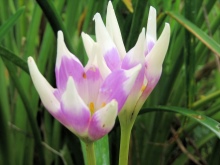
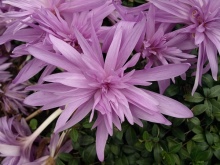
Late flowering varieties.
- Dick Trotter. Begins flowering in late September - early October. The petals are rounded, bright purple to the middle, turning greenish-white towards the center. Anthers are yellow. Plant height - up to 20 cm.
- Giant. The latest variety, its time is October. The flowers are large, pale lilac, white in the middle. The stem is tubular, pale green. Height - 25 cm.

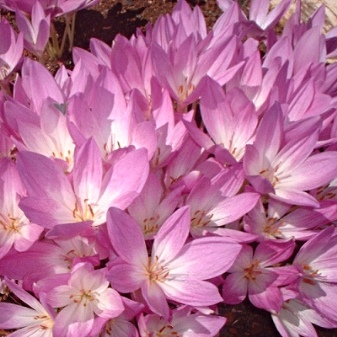
Planting and leaving
Growing colchicum magnificent outdoors is a task that even a beginner can handle. You just need to take into account some of the nuances.
- The plant is planted during a dormant period, when it sheds foliage and old roots. New ones will appear somewhere in August, respectively, it is in this month that it is recommended to plant a crocus.
- The tubers are placed in open ground with good breathability and drainage. Its composition is not so important, the main thing is that it is flavored with compost or humus. Undesirable close proximity of roots to groundwater - they will contribute to the rotting out of the entire root system and the death of the plant.
- If possible, plant a magnificent crocus in a lighted area, although it will also be fine in the shade.
- When the foliage begins to grow, the crocus will need additional moisture. But as soon as the leaves begin to turn yellow, watering should be stopped.
- Colchicum is magnificent - perennial, it can grow in one place for up to 7 years.
- Cut off faded buds with garden shears to keep the flower bed attractive.
- In the spring, feed the colchicum with nitrogen-containing fertilizer - this will promote the growth of large, succulent foliage.
- Autumn crocus does not require pruning. Just clean the plant of dried leaves and flowers.
- Wintering kolchikum implies the shelter of the growing area with fallen leaves. You do not need to dig out the corms.
- All manipulations with the crocus should be carried out with gloves - it is poisonous.
If the sap of the plant gets on the skin, it can cause burns.
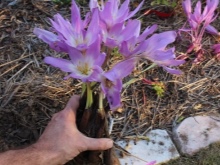


Diseases and pests
Colchicum magnificent is susceptible to attack slugs and snailsfeeding on its foliage. The methods of dealing with them are as follows: between rows with planted plants, it is recommended to pour fine gravel, crushed shell rock or eggshells. You can also protect the garden bed with plastic grooves with water poured into them - slugs will not be able to overcome this obstacle. When waterlogged soil, colchicum can be covered gray mold... Treatment: irrigation with "Champion", "Cuproxat" or "Topaz".
Severely affected parts must be cut and burned.
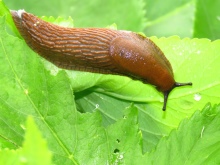


How to propagate?
There are 2 ways of reproduction of the magnificent colchicum: seed and root. Let's consider both.
Seminal
It is rarely used, since the plant obtained from the seed will bloom only after 5-8 years. In addition, this method is not suitable for all varieties. If you decide to experiment, then here are its stages.
- Collect seed in June. Don't store it, try to drop it as soon as possible.
- Prepare the soil: it should be loose and fertile. Avoid waterlogging.
- Cover the bottom of the planting tank with small pebbles or sand as a drainage layer.
- Soak the seed in water for a while, then sow it into the ground, not going too deep.
- Water the plantings from time to time.
Seeds can be stored for no more than 5 days and only in the cold. The first shoots will appear in the spring. As it gets warmer, you can move them to the site.
A huge plus of seed propagation is the possibility of obtaining more specimens than when dividing the bulb.
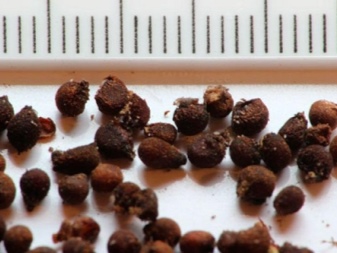
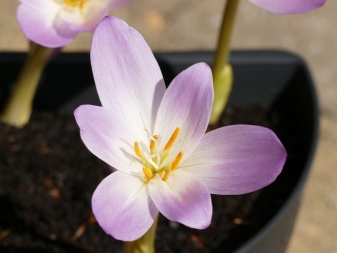
Root
Most often used. The breeding stages are as follows.
- Collect mature bulbs in mid-July. Proceed with caution.
- Carefully remove the remaining soil from the onions without touching the scales.
- Soak them in a weak potassium permanganate solution for 30 minutes.
- Remove the bulbs to dry.
- Place them in a dark and cool room (cellar) before disembarking.
- Onions are planted on the plot in August. Pre-loosen and fertilize the soil.
- The planting depth is 12 cm, the interval between specimens is 20 cm.
- It is recommended to transplant the crocus every 3 or 4 years with the destruction of old corms.


In the next video, you will find the features of growing crocus.







































































































The comment was sent successfully.